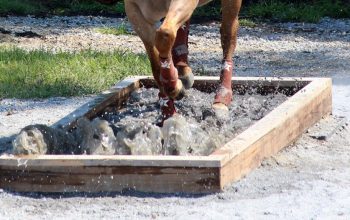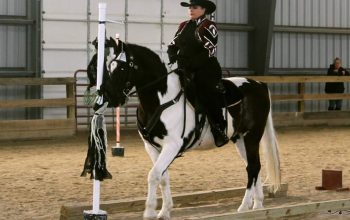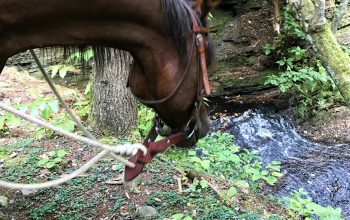 By Julie Alonzo, USA Working Equitation Secretary
By Julie Alonzo, USA Working Equitation Secretary
With riding, as with all endeavors, having goals toward which to work and clear paths by which to attain those goals can make the difference between success and frustration.
This is one of the reasons that so many people continue to be drawn to the sport of Working Equitation (WE). It offers a careful, measured progression from the very simple to the incredibly complex, and written scoresheets provide helpful commentary to guide riders along the path to improvement.
When I was first introduced to the sport, I had the naïve idea that getting my horse to the point where she would complete each of the obstacles was the key to doing well. Accordingly, I spent many hours building her confidence with entering a 5-foot wide corridor, standing quietly while I rang a bell over her head, and then backing out without knocking anything over. I introduced her to picking up a long pole out of a barrel and carrying it around without panicking when it crossed over her field of vision. I drilled the side pass pole and practiced crossing wooden bridges without changing her tempo.
And, yes, I also spent time memorizing the dressage test for my level and making sure I knew the pattern required to complete the slalom, double slalom, drums, and figure-8. On occasion, I also practiced jumping over hay bales or a simple pole set at the hay-bale height (but I have to admit the jump has always been my nemesis because I have terrible depth perception!).
Over the years, though, I have come to appreciate that Working Equitation is so much more than simply getting around obstacles. The sport rewards true partnership between horse and rider, quality transitions, and proper self-carriage. To do well, horse and rider must be able to demonstrate good working gaits (not necessarily extravagant ones, but the ability to move with consistency, rhythm, elasticity, and balance). The horse must use its back well (with relaxation and “push” coming from the hindquarters and through the back) and be comfortable maintaining connection.
 As a rider, I now know it’s my responsibility to prepare myself – and subsequently, my horse – for any and all transitions and changes in direction so that they do not come as a surprise (surprising my horse results in tension, and tension results in resistance and/or degradation of the quality of the horse’s movement). I am starting to learn the nuances of balance, leg contact, light connection through the reins, and how all of these interact to provide support for a quality go. I have learned more in the past 8 years about how to ride to a clear, straight and well-balanced halt than in my previous 36 year of riding combined.
As a rider, I now know it’s my responsibility to prepare myself – and subsequently, my horse – for any and all transitions and changes in direction so that they do not come as a surprise (surprising my horse results in tension, and tension results in resistance and/or degradation of the quality of the horse’s movement). I am starting to learn the nuances of balance, leg contact, light connection through the reins, and how all of these interact to provide support for a quality go. I have learned more in the past 8 years about how to ride to a clear, straight and well-balanced halt than in my previous 36 year of riding combined.
When I walk the course to plan my route for Ease of Handling and Speed, I am much more adept now than I used to be at making wise decisions about course lines that will enhance my horse’s performance and highlight her strengths. I am gaining better understanding of the ways in which different horses, at different stages in their development as riding mounts, require different course lines to excel.
One of the reasons I like the sport so much is that over the years it has helped so many people and horses improve their communication and become better partners. The WE community has cheered on countless horse/rider teams as they have progressed from being assisted through their first schooling rides at a WE competition to becoming truly competitive as they move up the levels.
Regardless of where one starts (beginning rider in their second half-century of life; child barely old enough to reach their pony’s chin; rider rehabilitating from traumatic brain injury (yes, we have a number of people recovering from TBIs who are active in the sport); weekend trail enthusiast looking for a fun way to spend time with others who love horses; or experienced rider with years of knowledge from other disciplines from which to draw), the sport offers opportunity for participation and growth.
 Of course, greater knowledge does not always translate to high scores in competition. Horses have a wonderful way of keeping us humble and constantly learning. An errant leaf rustling across the dressage court, a truck backfiring in the distance, a burst of unexpected static from a loudspeaker… there are countless ways in which a ride can be challenged.
Of course, greater knowledge does not always translate to high scores in competition. Horses have a wonderful way of keeping us humble and constantly learning. An errant leaf rustling across the dressage court, a truck backfiring in the distance, a burst of unexpected static from a loudspeaker… there are countless ways in which a ride can be challenged.
The beauty of the sport, however, is that the WE community understands and appreciates “try” – the WE family supports people at whatever level they enter and celebrates their progress, however rapid or slow.
 In November 2020, WE United joined with another organization to become USA Working Equitation (USAWE), the single national organization for the sport in the United States.
In November 2020, WE United joined with another organization to become USA Working Equitation (USAWE), the single national organization for the sport in the United States.
Learn more about USAWE: https://usawe.org/






